Top News
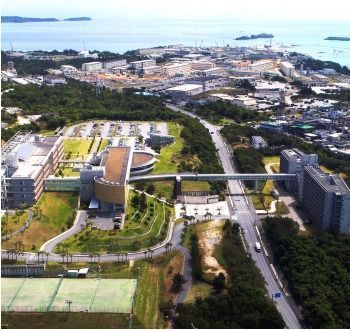
April 13, 2018 Ryukyu Shimpo
If construction of the replacement facility for Futenma Air Station in Henoko, Nago City is completed, some structures in Toyohara Ward and the Henoko Ordnance Ammunition Depot in Camp Schwab will surpass the height restrictions set by the U.S. military for safety purposes.
Also, should Japan’s civil aeronautics law apply to the replacement facility in Henoko, buildings will have to be limited to 45 meters in height within a radius of 3000 meters from a point of reference on the runway.
One after another, residential buildings and public facilities within this range that exceed the civil aeronautics law limitations have been identified.
The construction of the Futenma replacement facility is proceeding in a way that it will not comply with U.S. military standards, or standards set forth in Japan’s civil aeronautics law.
In an interview with the Ryukyu Shimpo, an official of the Okinawa Defense Bureau acknowledged that the Henoko Ordnance Ammunition Depot surpasses the 55-meter height restriction, and said, “We are coordinating with the U.S. for height restriction exceptions to be made.”
However, under the Act on Special Provisions of the Civil Aeronautics Act of the U.S.-Japan Status of Forces Agreement, U.S. military activity is exempt from civil aeronautics law safety regulations.
By making exemptions to regulations established for the purpose of safety by the U.S. and Japan, they become regulations in name only.
The U.S. Unified Facilities Criteria are becoming an issue in that they restrict the height of buildings constructed within 2286 meters of a runway.
Should the Henoko base be completed, there cannot be buildings exceeding approximately 55.7 meters.
In Toyohara Ward there are buildings that potentially breach these criteria on building height. These inlcude buildings around 57 to 60 meters tall in the vicinity of Kube Post Office and the Northern Okinawa Employment Capacity Development Coordination Center, and even public facilities and community sites about 50 meters tall.
In addition to this, since the Henoko Ordnance Ammunition Depot stores explosive materials, not adhering to height limitations meant to ensure safe aviation near the depot will likely spread concern in terms of the safety of the replacement facility.
It is already understood that National Institute of Technology, Okinawa College (NIT-Ok) buildings, Okinawa Electric Power Company utility poles, and telecommunication companies’ utility poles exceed the height restriction of approximately 55.7 meters.
In regard to this, an official of the ODB stated, “Except for Okinawa Electric’s utility po]les and telecommunication companies’ utility poles, we have assessed that even areas exceeding the height restriction of 55 meters will not impede the operation of aircraft, so exceptions to the height limit will be made.”
On April 11, the ODB made calls to NIT-Ok, Toyohara Ward, and Henoko Ward, among others, to explain measures being taken to make exceptions to building height restrictions.
(English translation by T&CT and Erin Jones)
Go to Japanese
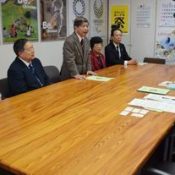
April 14, 2018 Ryukyu Shimpo
The “Committee to promote UNESCO intangible heritage list enrollment,” led by Masaki Yasuda, visited Okinawa Prefecture’s Department of Culture, Tourism, and Sports chief Takao Kadekaru at the prefectural office to inform him of their effort to put Ryukyu cuisine as well as Ryukyu awamori made from black koji mold onto the UNESCO intangible heritage list.
Committee chair Yasuda said, “Originally, the only liquor made from black koji mold was awamori.
We would like to re-examine awamori as well as the Ryukyu cuisine that helped establish Japan as the land of longevity, secure their place on this list, and preserve it for future generations.”
At the conference, committee deputy chair Chokei Taira (head of the Okinawa Convention & Visitors Bureau (OCVB)) announced his intention to establish a working committee for Ryukyu cuisine and awamori within the Bureau with the goal of getting them on the UNESCO list.
In the report, it was stated that four symposiums had been held previously, and interest from Okinawan citizens had grown.
Furthermore, the report stressed that Ryukyuan cuisine’s dynastic aspect as well as the food’s perceived curative properties, along with the awamori made with black koji mold, a fermenter unique to Okinawa, made for a combination of food and drink that had a unique value in the cultural sphere, and that is was essential to secure a place on the intangible heritage list.
(English translation by T&CT and Sam Grieb)
Go to Japanese
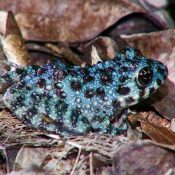
April 13, 2018 Ryukyu Shimpo
Kazuo Minato, a 59- year-old animal photographer from Nishihara town, found a blue Okinawa Ishikawagaeru (Odorrana ishikawae) which he managed to capture in a close-range photo.
It is said that the species is Japan’s most beautiful frog, and the species is registered as the prefecure’s natural monument.
The photographer was walking on the forest road to look for animals at midnight on April 10.
He managed to photograph the frog, to which he commented “I’m happy to encounter the blue frog for the first time.”
Minato has been taking photos of insects and animals in the rich nature of Yambaru forest for the past four decades.
He has watched hundreds of green Okinawa Ishikawagaeru, but it was his first time seeing a blue frog.
He later said that he could not find many animals after walking in the forest for three hours since the forest was dry.
He found the blue frog just as he had called it quits for the night and started to headed back.
He remembers, “although Okinawa Ishikawagaeru have their breeding season in winter, I heard its call and thought ‘oh they are still around’.”
Minato said, “I knew there were blue frogs, but I also heard that they are spread around so I wanted to see it.”
The frog was about three to four centimeters and is considered as a young one.
Atsushi Tominaga, an associate professor at the University of the Ryukyus, explains, “The frogs turn blue when they lack yellow chromatophore. The blue Okinawa Ishikawagaeru is reported to be seen these days more often than before, but it is still rare to find them.”
(English translation by T&CT and Sayaka Sakuma)
Go to Japanese
April 13, 2018 Ryukyu Shimpo
By Masanao Chinen
On April 1, Okinawa Prefecture opened a “Be.Okinawa Inbound Medical Interpretation Contact Center” to provide interpretation by phone at medical sites where communication with foreign tourists is an issue.
Travel agents and medical institutions can receive interpreter service 24 hours a day, 365 days a year by calling the center.
The center aims to alleviate the burden on the staff at medical facilities, as well as to set up a hospitable environment for foreigners.
The center supports interpretations in six languages including English, Chinese, and Korean.
There is no charge for the service aside from the rate for a telephone call.
In order to avoid amassing inquiries, the center only provides the number to tourist enterprises such as hotels, tourist facilities, medical institutions, and fire authorities.
In 2017, foreign tourists to Okinawa increased by 22.1 percent from the previous year to about 2.54 million people, and the demand for medical attention also rose.
In a field trial at 16 medical intuitions in 2016, most foreigners’ medical needs were for mild symptoms such as colds and minor injuries.
There were requests to expand the trial to clinics as well. The Be.Okinawa Center expanded its trial to include about one thousand medical institutions in the prefecture.
Troubles related to treatment policies and medical expenses are also occurring in the medical field.
The center expects that these problems could be reduced through interventions by expert interpreters.
The Prefectural Government’s Culture, Tourism and Sports Division Director Takao Kadekaru called for the center to be used to reduce the burden at medical sites.
For inquiries such as the Be.Okinawa Contact Center’s number of business operators, call the administrative office at 098 (868) 5230.
(English translation by T&CT and Megumi Chibana)
Go to Japanese
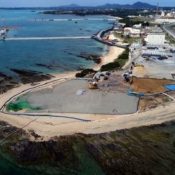
April 10, 2018 Ryukyu Shimpo
On April 9, the Okinawa Defense Bureau (ODB) started work on N3 seawall in Henoko, part of construction for a replacement facility for Futenma Air Station.
N3 is the final section needed to enclose one area on the south side of Cape Henoko, into which soil will be deposited following enclosure.
The same day at a meeting of the Environmental Oversight Committee, the ODB made an announcement in regard to a colony of scarce Stylaraea punctata coral found outside the ocean area planned for land reclamation work.
Rather than getting approval from the governor of Okinawa to transplant the coral, the ODB changed its plan to simply moving forward with construction.
In July the ODB aims to fill in the ocean area that will be enclosed by the N3 seawall and two already-constructed seawalls.
It is a foregone conclusion that the Okinawa Prefectural Government opposes the Japanese government speeding up embankment work. 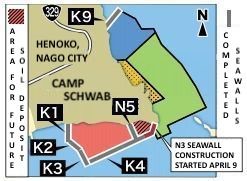
The N3 seawall that is under construction will stretch southwest from near the tip of Cape Henoko, and will complete the south side land reclamation boundaries.
N3 will measures 135 meters in length, and is the 7th seawall section to be constructed. On April 9 around 9:40 a.m., rock-laying work began.
When N3 embankment is completed and is connected to the K4 and N5 embankments, it will enclose the land reclamation boundaries and make it possible to deposit soil near the tip of Cape Henoko.
Construction of N3 is expected to take about two months for completion in June. The Japanese government is also hoping to connect these three embankments during June.
Concerning the plan to move embankment work forward without transplanting the colony of Stylaraea punctata, the ODB has mentioned the potential of decreasing the amount of rock put into the ocean per day, and increasing the number of silt barriers set up around the seawalls from two layers to four layers so as not to affect the surroundings.
The Environmental Oversight Committee also accepted this change.
Instead of once again applying for special harvesting approval from the OPG, which opposes Henoko base construction, the Japanese government appears to be trying to evade any authority that the governor can exercise.
The Japanese government has also demonstrated that its objective is to speed up construction by increasing the number of cargo ships used to haul in crushed rock to two.
(English translation by T&CT and Erin Jones)
Go to Japanese
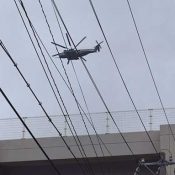
April 6, 2018 Ryukyu Shimpo
In December last year a window from a large U.S. military helicopter fell on the sports field of Futenma Daini Elementary School in Ginowan City, Okinawa.
The sports field was reopened for use on February 13 and remained open until the end of the school’s third term on March 23.
Futenma Daini Elementary concluded that over these 39 days of the field being open for use, pupils had to evacuate the field and take shelter inside 242 times due to the approach of U.S. aircraft.
The highest number of times in a day that pupils had to take shelter was 29 times.
Evacuations took place more that 20 times a day on three separate occasions during this 39-day period.
Taking shelter from the approach of U.S. aircraft has interrupted the children’s physical education lessons.
The U.S. military has not suspended flights in the vicinity of schools, so children’s right to receive education is being constantly infringed upon.

On January 19 in Ginowan City, a large U.S. military CH-53E helicopter approaches Futenma Daini Elementary from the air.
From 8:45 a.m. to 4:30 p.m. while school is in session at Futenma Daini Elementary School, the Okinawa Defense Bureau (ODB) monitors U.S. military aircraft flights from Kakazu Hill.
When notification is received from the ODB confirming that a U.S. military aircraft has taken off in the direction of the school, an evacuation instruction is issued.
When an instruction is issued, students who are in the sports field or other outdoor areas take shelter indoors.
Most of the class work that takes place on the sports field is physical education.
Sometimes multiple evacuation instructions were announced during one class session.
The school principal said, “If there are two evacuations, a lesson comes to naught.”
Also, the principal voiced the concern that it seems likely some lessons could not be completed over the class period and that, “The curriculum that should have been learned could not be completed.”
The only days during the 39-day period that no evacuation instructions were issued were February 19 and 20 which are U.S. military holidays, March 22 when the children were indoors for their graduation ceremony, and March 23 when they were indoors for their completion ceremony.
Futenma Daini Elementary faces a dilemma; it wants to quickly return to a regular routine, but it cannot afford to reduce evacuations and put its pupils in danger.
The principal said, “Upon seeing how the pupils fare in the upcoming school term, we want to discuss with the parents, guardians, and the city Board of Education regarding how to handle the situation.”
Go to Japanese
April 5, 2018 Ryukyu Shimpo
It was learned on April 4 that during parachute training conducted by U.S. soldiers on April 3 at Ie Jima Auxiliary Airfield in Ie, Okinawa, a parachute was dropped outside of the designated area. The parachute landed about 50 meters from a residence on nearby farmland. It has not been confirmed if this resulted in any damage.
Since parachute training was moved to Ie Jima in 1996 as part of the Special Action Committee on Okinawa (SACO), there have been countless incidents of personnel and materials landing outside of the target drop-zone, and have come very close to potentially causing serious damage. Area residents have been voicing opposition to the situation, saying, “We have protested many times, but the U.S. military does whatever they want without hearing our voices.”
At the time of the incident, eight U.S. Army soldiers were conducting parachute training, jumping from a C-130 from an elevation of 10,000 ft. (about 3 km). According to the village of Ie, the incident happened around 6:20 p.m. One of the soldier’s parachutes would not open and was cut free, and dropped to the farm below. The soldier landed within the target drop-zone using their backup parachute, and was not injured.
The dropped parachute landed about 150 meters from the airfield’s fence, and about 200 meters from “Unity Dojo,” which has become the hub of the island’s anti-military resistance movement. At around 6:30 p.m. on April 3, the village received word of the incident from the local U.S. Military relations director. The parachute had already been collected by the military, so the size and weight is unknown. The village has said that, “There was no damage.”
In November of last year, there was also an incident where two U.S. soldiers went over the fence while doing parachute training at Ie Jima, and landed about 350 meters from a house on farmland. Yoshihisa Heizan, chief administrator of Maja Ward, which neighbors the Ie Jima Auxiliary Airfield, angrily stated, “There have been incidents like this more times than I can count, so every time there is and exercise we watch the skies. Who knows when someone is going to land on one of our heads?”
The Okinawa Defense Bureau (ODB), who were contacted by Ie Village, reported the dropped parachute at around 10:00 p.m. on April 3 to the Okinawa Prefectural government. Upon hearing the news, base policy director Norikazu Kinjo phoned the ODB on April 4, demanding, “This is an accident that makes area residents uneasy. Approach the U.S. military to ensure that they are taking every possible measure to not worry or put at risk local residents.”
Meanwhile, the ODB told Ryukyu Shimpo reporters, “We have confirmed that no residents were in the area at the time of the incident. We are inquiring with the U.S. military about the situation.”
(English translation by T&CT and Sam Grieb)
Go to Japanese
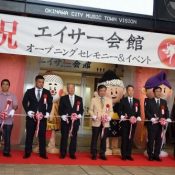
March 25, 2018 Ryukyu Shimpo
An opening ceremony for Eisa Hall was held at Koza Music Town in Okinawa city on March 25, with many citizens attending the ceremony. The facility is expected to play a role as a comprehensive information hub for eisa dance. The entrance fee was free on March 25 until the hall closed at 9:00 p.m. (last admittance at 8:30).
The exhibit is unique in a way that visitors can not only learn about the history of eisa and its development, but they can also actually experience various activities. There is some space where visitors can practice the shimedaiko (hand-held drum) and odaiko (big drum), as well as a place where visitors can take photos in eisa costumes. Okinawa City developed the facility utilizing a government subsidy.
Okinawa City Mayor Sachio Kuwae spoke at the ceremony saying, “We will make this a place where people can feel the dance, and where we can widely appeal the value of eisa,” calling for many visitors to come to the hall.
The facility is closed on Wednesdays. Business hours are from 10:00 a.m. to 9:00 p.m. The entrance fee for adults is 300 yen, and 100 yen for elementary school students to high school students. Kids younger than elementary school age can enter the facility for free. For more information, contact the Eisa Hall at 098-989-5066.
(English translation by T&CT and Sayaka Sakuma)
Go to japanese
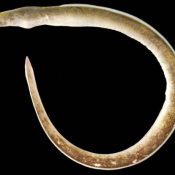
April 6, 2018 Ryukyu Shimpo
On April 5, the research group of Okinawa Churashima Foundation Research Center announced that the snake eel found at the Genka River of Nago City last June was in fact a Mindoro snake eel Lamnostoma mindorum.
This particular Hydrophiinae was discovered for the first time in Japan.
This is also the first time in which a Hydrophiinae that inhabits fresh water was found in Japan.
It was named kawa-umi hebi, or river-sea snake, in Japanese.
This is the sixth location that this snake eel has been found in the world and it was discovered at the northern limit of the Genka River.
Office worker Tetsuya Shintani and his sixth-grade son Shunpei from Kyoto City made the discovery.
They had found the snake eel in the Genka River and had taken it home to raise.
When Shintani had inquired with the foundation regarding rearing methods, the possibility of it being a new species being spotted for the first time in Japan arose, especially since it was discovered in fresh water.
Unfortunately, the snake eel died last year around October, so Shintani and his son had presented it to the research center as a specimen.
The research center then looked into the body type and number of bones.
After comparing their information with an article on the morphology of the same species found in Taiwan, the research team was able to confirm that it was in fact a Lamnostoma mindorum.
Research center Animal Study Section Chief Shinichiro Oka said, “This discovery points to just how biologically diverse Okinawa is.
The fact that general citizens made this discovery is significant as well.”
The discovery was publicized on “Fauna Ryukuana,” an academic journal that covers animal distribution in the Ryukyu Islands.
(English translation by T&CT and Chelsea Ashimine)
Go to Japanese
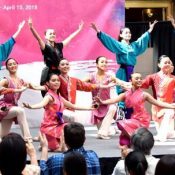
March 26, 2018 Ryukyu Shimpo
The NS Ryukyuan Ballet Company led by Director Sayo Nagasaki held its first overseas performance at the Smithsonian American Art Museum in Washington D.C. The group performed an original ballet that incorporates various factors such as Ryukyuan dance, entertaining the audiences.
The stage was held as a part of the U.S. annual cherry blossom festival. Nineteen performers aged 14-22 danced ten uplifting songs including Wakajishi, Hatoma-bushi, and Medetai-bushi, to celebrate the coming of spring.
The audiences praised the group that brought Okinawan melodies to the venue.
Dancer Makoto Matayoshi, 22, talked about her experience at her first overseas performance, commenting, “I’m very glad that so many people came to watch our first stage performance in the U.S. I could see they enjoyed each song.
” Another 22-year-old performer, Yuka Asato, commented, “We received cheers and applause from the very beginning, and that encouraged us. It was a really good experience.”
The ballet group will perform at Disney World in Florida on March 28, and in Tampa on March 31.
(English translation by T&CT and Sayaka Sakuma)
Go to Japanese
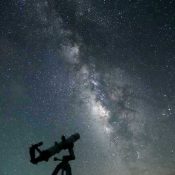
April 3, 2018 Ryukyu Shimpo
On April 2, Ishigaki City and Taketomi Town were together designated as a Dark Sky Place by the International Dark-Sky Association (IDA) based in Arizona.
It is the first time a location in Japan has received accreditation through the Dark Sky Places Program.
Since their starry skies have been recognized as a standing out against the world standard, the city and town governments are considering using their skies as a new way to attract tourism, as well as taking the opportunity to promote efforts to preserve their starry skies.
The accreditation was awarded on March 30 (local time), and the Ishigaki City and Taketomi Town governments received notification on April 2.
The IDA established the Dark Sky Place Program to promote efforts toward preserving beautiful night skies, and designation requires compliance with strict standards on outdoor lighting.
In July 2017 the city and town governments applied for Iriomote-Ishigaki National Park to be designated as a Dark Sky Park.
It was the first time any place in Japan applied for IDA recognition.
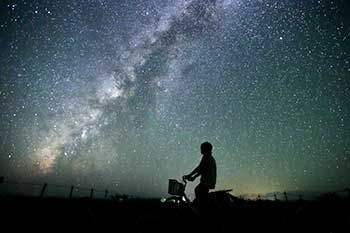
The night sky over Kuroshima, Taketomi Town (photograph taken in September 2015 and provided by Hoshizora Tourism Ltd.)
This national park encompasses 40,653 square hectares of the northern part of Ishigaki Island including all of Taketomi Town.
There are 96 places in the world designated by the IDA, which are separated into five distinct categories.
Dark Sky Parks are one category, and account for 59 of these sites.
However, because some of the streetlights in Taketomi Town do not yet adhere to designation standards, the IDA has awarded the area ‘Provisional’ International Dark Sky Park status on the condition that the town takes steps to comply with these standards.
Ishigaki City welcomes the designation as it hopes its starry skies will draw more tourism.
Taketomi Town also welcomes the accreditation as an opportunity to promote overnight and long-term visitation.
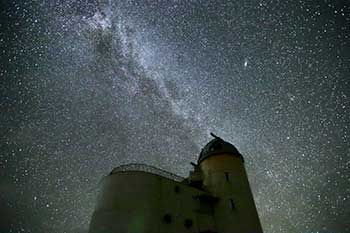
This Dark Sky Place captured from Hateruma Island, Taketomi Town (photograph taken in October 2015 and provided by Hoshizora Tourism Ltd.)
The city and town governments plan to raise public awareness among residents concerning the importance of Dark Sky designation.
Ishigaki City aims to establish regulations for preservation of its dark skies, which are meant to impose light pollution restrictions in the city this year.
(English translation by T&CT and Erin Jones)
Go to Japanese













 Webcam(Kokusai Street)
Webcam(Kokusai Street)


